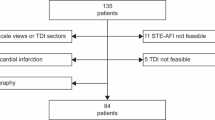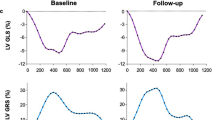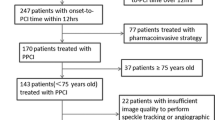Abstract
Background
Identification of transmural extent and degree of non-viability after ST-segment elevation myocardial infarction (STEMI) is clinically important. The objective of the present study was to assess the regional mechanics and temporal deformation patterns using speckle tracking echocardiography (STE) in acute and later phases of STEMI to predict myocardial damage in these patients.
Methods and results
Ninety-eight patients with first STEMI underwent both echocardiography and cardiac magnetic resonance imaging in acute phase and at 6 months follow-up with 2D STE-derived measurements of peak longitudinal strain (PLS), Pre-STretch index (PST) and post-systolic deformation index (PSI). For each segment, late gadolinium enhancement (LGE) was defined as transmural (LGE >66 %) or non-transmural (<66 %). Global deformation values were significantly correlated with LVEFCMR and infarct size at both visits. A significantly lower value of segmental PLS and higher PSI and PST in necrotic segments were observed comparatively to control, adjacent and remote segments. The best parameters to predict transmural extent in acute phase were PSI with a cutoff value of 8 % (AUC: 0.84) and PLS with a cutoff value of −13 % (AUC: 0.86). PST showed high specificity, but poor sensitivity in predicting transmural extent. More importantly, the addition of PSI and PST to PLS in acute phase was associated with improved prediction of viability at 6 months (integrated discrimination improvement 2.5 % p < 0.01; net reclassification improvement 27 %; p < 0.01).
Conclusions
All systolic deformation values separated transmural from non-transmural scarring. PLS combined with additional information relative to post-systolic deformation appears to be the most informative parameters to predict the transmural extent of MI in the early and late phases of MI.
Clinical trial registration
http://clinicaltrials.gov/show/NCT01109225; NCT01109225.





Similar content being viewed by others
References
Stark R, Kirchberger I, Hunger M, Heier M, Leidl R, von Scheidt W, Meisinger C, Holle R (2014) Improving care of post-infarct patients: effects of disease management programmes and care according to international guidelines. Clin Res Cardiol 103:237–245
Kühl HP, Beek AM, van der Weerdt AP, Hofman MBM, Visser CA, Lammertsma AA, Heussen N, Visser FC, van Rossum AC (2003) Myocardial viability in chronic ischemic heart disease: comparison of contrast-enhanced magnetic resonance imaging with (18)F-fluorodeoxyglucose positron emission tomography. J Am Coll Cardiol 41:1341–1348
Shan K, Constantine G, Sivananthan M, Flamm SD (2004) Role of cardiac magnetic resonance imaging in the assessment of myocardial viability. Circulation 109:1328–1334
Riffel JH, Keller MGP, Aurich M, Sander Y, Andre F, Giusca S, Aus dem Siepen F, Seitz S, Galuschky C, Korosoglou G, Mereles D, Katus HA, Buss SJ (2015) Assessment of global longitudinal strain using standardized myocardial deformation imaging: a modality independent software approach. Clin Res Cardiol 104:591–602
Voigt J-U, Pedrizzetti G, Lysyansky P, Marwick TH, Houle H, Baumann R, Pedri S, Ito Y, Abe Y, Metz S, Song JH, Hamilton J, Sengupta PP, Kolias TJ, D’hooge J, Aurigemma GP, Thomas JD, Badano LP (2015) Definitions for a common standard for 2D speckle tracking echocardiography: consensus document of the EACVI/ASE/Industry Task Force to standardize deformation imaging. J Am Soc Echocardiogr 28:183–193
Kukulski T, Jamal F, Herbots L, D’hooge J, Bijnens B, Hatle L, De Scheerder I, Sutherland GR (2003) Identification of acutely ischemic myocardium using ultrasonic strain measurements. A clinical study in patients undergoing coronary angioplasty. J Am Coll Cardiol 41:810–819
Asanuma T, Fukuta Y, Masuda K, Hioki A, Iwasaki M, Nakatani S (2012) Assessment of myocardial ischemic memory using speckle tracking echocardiography. JACC Cardiovasc Imaging 5:1–11
Huttin O, Petit M-A, Bozec E, Eschalier R, Juillière Y, Moulin F, Lemoine S, Selton-Suty C, Sadoul N, Mandry D, Beaumont M, Felblinger J, Girerd N, Marie P-Y (2015) Assessment of left ventricular ejection fraction calculation on long-axis views from cardiac magnetic resonance imaging in patients with acute myocardial infarction. Medicine (Baltimore) 94:e1856
Huttin O, Lemarié J, Di Meglio M, Girerd N, Mandry D, Moulin F, Lemoine S, Juillière Y, Felblinger J, Marie P-Y, Selton-Suty C (2015) Assessment of right ventricular functional recovery after acute myocardial infarction by 2D speckle-tracking echocardiography. Int J Cardiovasc Imaging 31:537–545
Huttin O, Zhang L, Lemarié J, Mandry D, Juillière Y, Lemoine S, Micard E, Marie P-Y, Sadoul N, Girerd N, Selton-Suty C (2015) Global and regional myocardial deformation mechanics of microvascular obstruction in acute myocardial infarction: a three dimensional speckle-tracking imaging study. Int J Cardiovasc Imaging 31:1337–1346
Curtis JP, Sokol SI, Wang Y, Rathore SS, Ko DT, Jadbabaie F, Portnay EL, Marshalko SJ, Radford MJ, Krumholz HM (2003) The association of left ventricular ejection fraction, mortality, and cause of death in stable outpatients with heart failure. J Am Coll Cardiol 42:736–742
Kosiuk J, Dinov B, Bollmann A, Koutalas E, Mussigbrodt A, Sommer P, Arya A, Richter S, Hindricks G, Breithardt OA (2015) Association between ventricular arrhythmias and myocardial mechanical dispersion assessed by strain analysis in patients with nonischemic cardiomyopathy. Clin Res Cardiol 104:1072–1077
Vartdal T, Brunvand H, Pettersen E, Smith H-J, Lyseggen E, Helle-Valle T, Skulstad H, Ihlen H, Edvardsen T (2007) Early prediction of infarct size by strain Doppler echocardiography after coronary reperfusion. J Am Coll Cardiol 49:1715–1721
Gjesdal O, Hopp E, Vartdal T, Lunde K, Helle-Valle T, Aakhus S, Smith H-J, Ihlen H, Edvardsen T (2007) Global longitudinal strain measured by two-dimensional speckle tracking echocardiography is closely related to myocardial infarct size in chronic ischaemic heart disease. Clin Sci 113:287
Pislaru C, Bruce CJ, Anagnostopoulos PC, Allen JL, Seward JB, Pellikka PA, Ritman EL, Greenleaf JF (2004) Ultrasound strain imaging of altered myocardial stiffness: stunned versus infarcted reperfused myocardium. Circulation 109:2905–2910
Lieberman AN, Weiss JL, Jugdutt BI, Becker LC, Bulkley BH, Garrison JG, Hutchins GM, Kallman CA, Weisfeldt ML (1981) Two-dimensional echocardiography and infarct size: relationship of regional wall motion and thickening to the extent of myocardial infarction in the dog. Circulation 63:739–746
Gjesdal O, Helle-Valle T, Hopp E, Lunde K, Vartdal T, Aakhus S, Smith H-J, Ihlen H, Edvardsen T (2008) Noninvasive separation of large, medium, and small myocardial infarcts in survivors of reperfused ST-elevation myocardial infarction: a comprehensive tissue Doppler and speckle-tracking echocardiography study. Circ Cardiovasc Imaging. 1:189–196 (2 p following 196)
Derumeaux G, Ovize M, Loufoua J, André-Fouet X, Minaire Y, Cribier A, Letac B (1998) Doppler tissue imaging quantitates regional wall motion during myocardial ischemia and reperfusion. Circulation 97:1970–1977
Terkelsen CJ, Poulsen SH, Nørgaard BL, Lassen JF, Gerdes JC, Sloth E, Nielsen TT, Andersen HR, Egeblad H (2007) Does postsystolic motion or shortening predict recovery of myocardial function after primary percutanous coronary intervention? J Am Soc Echocardiogr 20:505–511
Lyseggen E, Skulstad H, Helle-Valle T, Vartdal T, Urheim S, Rabben SI, Opdahl A, Ihlen H, Smiseth OA (2005) Myocardial strain analysis in acute coronary occlusion a tool to assess myocardial viability and reperfusion. Circulation 112:3901–3910
Voigt J-U, Lindenmeier G, Exner B, Regenfus M, Werner D, Reulbach U, Nixdorff U, Flachskampf FA, Daniel WG (2003) Incidence and characteristics of segmental postsystolic longitudinal shortening in normal, acutely ischemic, and scarred myocardium. J Am Soc Echocardiogr 16:415–423
Asanuma T, Uranishi A, Masuda K, Ishikura F, Beppu S, Nakatani S (2009) Assessment of myocardial ischemic memory using persistence of post-systolic thickening after recovery from ischemia. JACC Cardiovasc Imaging 2:1253–1261
Boden WE, Brooks WW, Conrad CH, Bing OH, Hood WB Jr (1995) Incomplete, delayed functional recovery late after reperfusion following acute myocardial infarction: “maimed myocardium”. Am Heart J 130:922–932
Lew WY, Ban-Hayashi E (1985) Mechanisms of improving regional and global ventricular function by preload alterations during acute ischemia in the canine left ventricle. Circulation 72:1125–1134
Roes SD, Mollema SA, Lamb HJ, van der Wall EE, de Roos A, Bax JJ (2009) Validation of echocardiographic two-dimensional speckle tracking longitudinal strain imaging for viability assessment in patients with chronic ischemic left ventricular dysfunction and comparison with contrast-enhanced magnetic resonance imaging. Am J Cardiol 104:312–317
Cimino S, Canali E, Petronilli V, Cicogna F, De Luca L, Francone M, Sardella G, Iacoboni C, Agati L (2013) Global and regional longitudinal strain assessed by two-dimensional speckle tracking echocardiography identifies early myocardial dysfunction and transmural extent of myocardial scar in patients with acute ST elevation myocardial infarction and relatively preserved LV function. Eur Heart J Cardiovasc Imaging 14:805–811
Jurcut R, Pappas CJ, Masci PG, Herbots L, Szulik M, Bogaert J, Van de Werf F, Desmet W, Rademakers F, Voigt J-U, D’hooge J (2008) Detection of regional myocardial dysfunction in patients with acute myocardial infarction using velocity vector imaging. J Am Soc Echocardiogr 21:879–886
Smedsrud MK, Sarvari S, Haugaa KH, Gjesdal O, Ørn S, Aaberge L, Smiseth OA, Edvardsen T (2012) Duration of myocardial early systolic lengthening predicts the presence of significant coronary artery disease. J Am Coll Cardiol 60:1086–1093
Jansen AHM, Bracke F, Dantzig J melle van, Peels KH, Post JC, Bosch HCM van den, Gelder B van, Meijer A, Korsten HHM, Vries J de, Hemel NM van. The influence of myocardial scar and dyssynchrony on reverse remodeling in cardiac resynchronization therapy. Eur J Echocardiogr. 2008;9:483–8
Sengupta PP. Exploring left ventricular isovolumic shortening and stretch mechanics: “The heart has its reasons…”. JACC Cardiovasc Imaging. 2009;2:212–5
Products—Health United States—Tables—2011 Complete List [Internet] [cited 2014 Jul 6]. http://www.cdc.gov/nchs/hus/contents2011.htm#123
Acknowledgments
The study was supported by a grant from the French Ministry of Health (Programme de Recherche Clinique Inter-régional 2009) and sponsored by the CHU Nancy, Nancy, France.
Author information
Authors and Affiliations
Corresponding author
Ethics declarations
Conflict of interest
None.
Additional information
N. Girerd and C. Selton-Suty contributed equally to this manuscript.
Electronic supplementary material
Below is the link to the electronic supplementary material.
Rights and permissions
About this article
Cite this article
Huttin, O., Marie, PY., Benichou, M. et al. Temporal deformation pattern in acute and late phases of ST-elevation myocardial infarction: incremental value of longitudinal post-systolic strain to assess myocardial viability. Clin Res Cardiol 105, 815–826 (2016). https://doi.org/10.1007/s00392-016-0989-6
Received:
Accepted:
Published:
Issue Date:
DOI: https://doi.org/10.1007/s00392-016-0989-6




